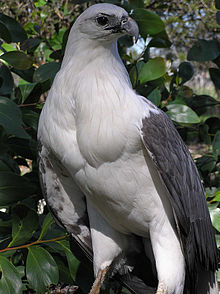White-bellied sea eagle
The white-bellied sea eagle (Haliaeetus leucogaster), is also known as the white-breasted sea eagle. It is a large daytime bird of prey in the family Accipitridae. It is closely related to Sanford's sea eagle of the Solomon Islands.
| White-bellied sea eagle | |
|---|---|

| |
| In Gippsland, Victoria | |
| Scientific classification | |
| Domain: | Eukaryota |
| Kingdom: | Animalia |
| Phylum: | Chordata |
| Class: | Aves |
| Order: | Accipitriformes |
| Family: | Accipitridae |
| Genus: | Haliaeetus |
| Species: | H. leucogaster
|
| Binomial name | |
| Haliaeetus leucogaster Gmelin, 1788
| |

| |
| Range of both this species and Sanford's sea eagle shown in green, but the latter demarcated within a paler blue circle | |
| Synonyms | |
|
Ichthyaetus blagrus Blyth, 1843 | |
It is a distinctive bird, with a white belly, white head, breast, under-wing coverts and tail. The upper parts are grey. The black under-wing flight feathers contrast with the white coverts. The tail is short and wedge-shaped as in all Haliaeetus species. Like many raptors, the female is slightly larger than the male, and can be 90 cm (35 in) long with a wingspan of up to 2.2 m (7.2 ft), and weigh 4.5 kg (9.9 lb). Immature birds have brown plumage, which is gradually replaced with white by the age of five or six years. Its call is a loud goose-like honking.
The bird lives in India and Sri Lanka through Southeast Asia to Australia on coasts and major waterways. It breeds and hunts near water, and fish form around half of its diet.
Opportunistic, it eats carrion and a wide variety of animals. Although rated of Least Concern globally, it has declined in parts of southeast Asia. It is ranked as Threatened in Victoria and Vulnerable in South Australia and Tasmania. Human disturbance to its habitat is the main threat. The white-bellied sea eagle is revered by indigenous people in many parts of Australia, and is the subject of various folk tales throughout its range.
